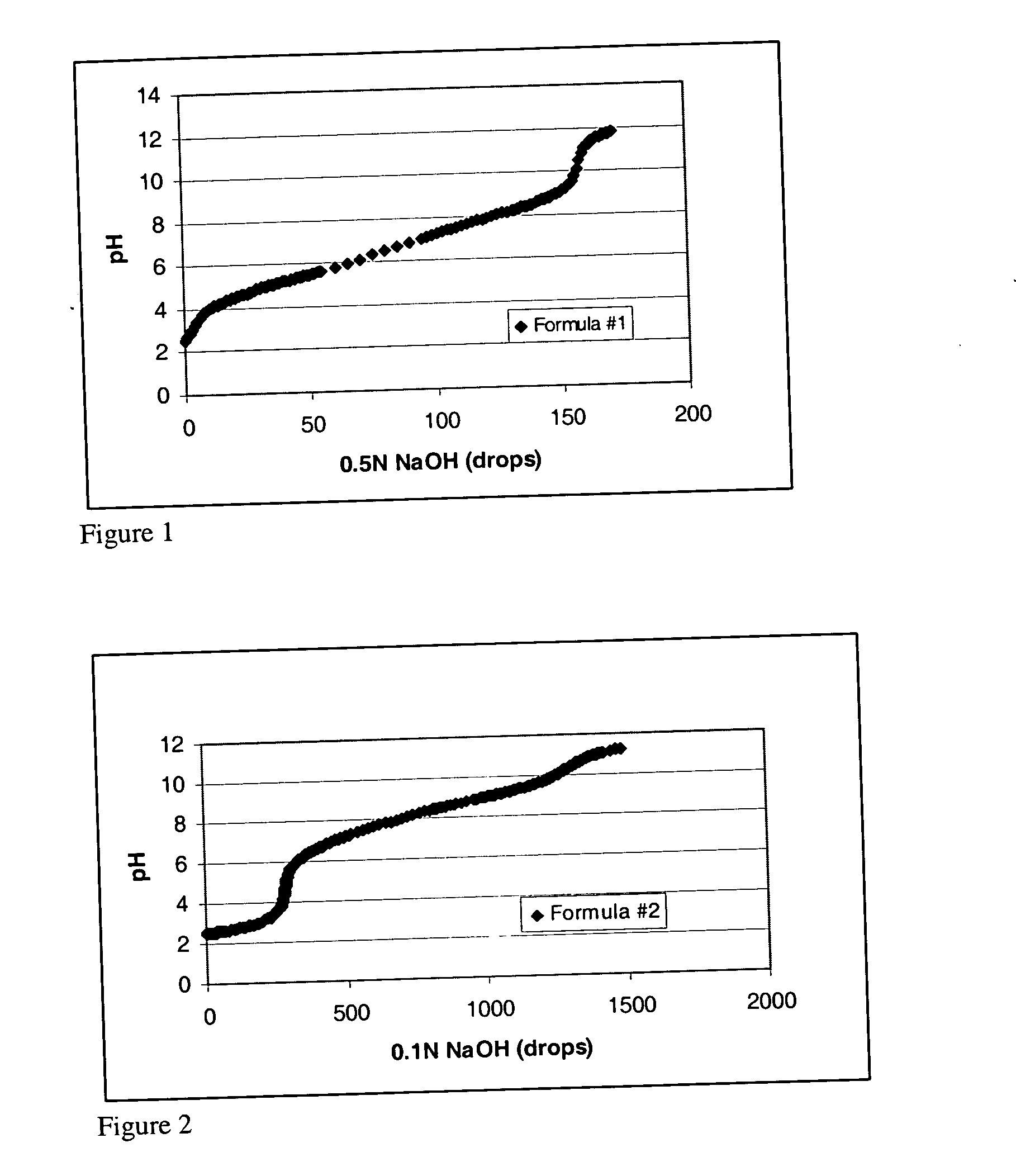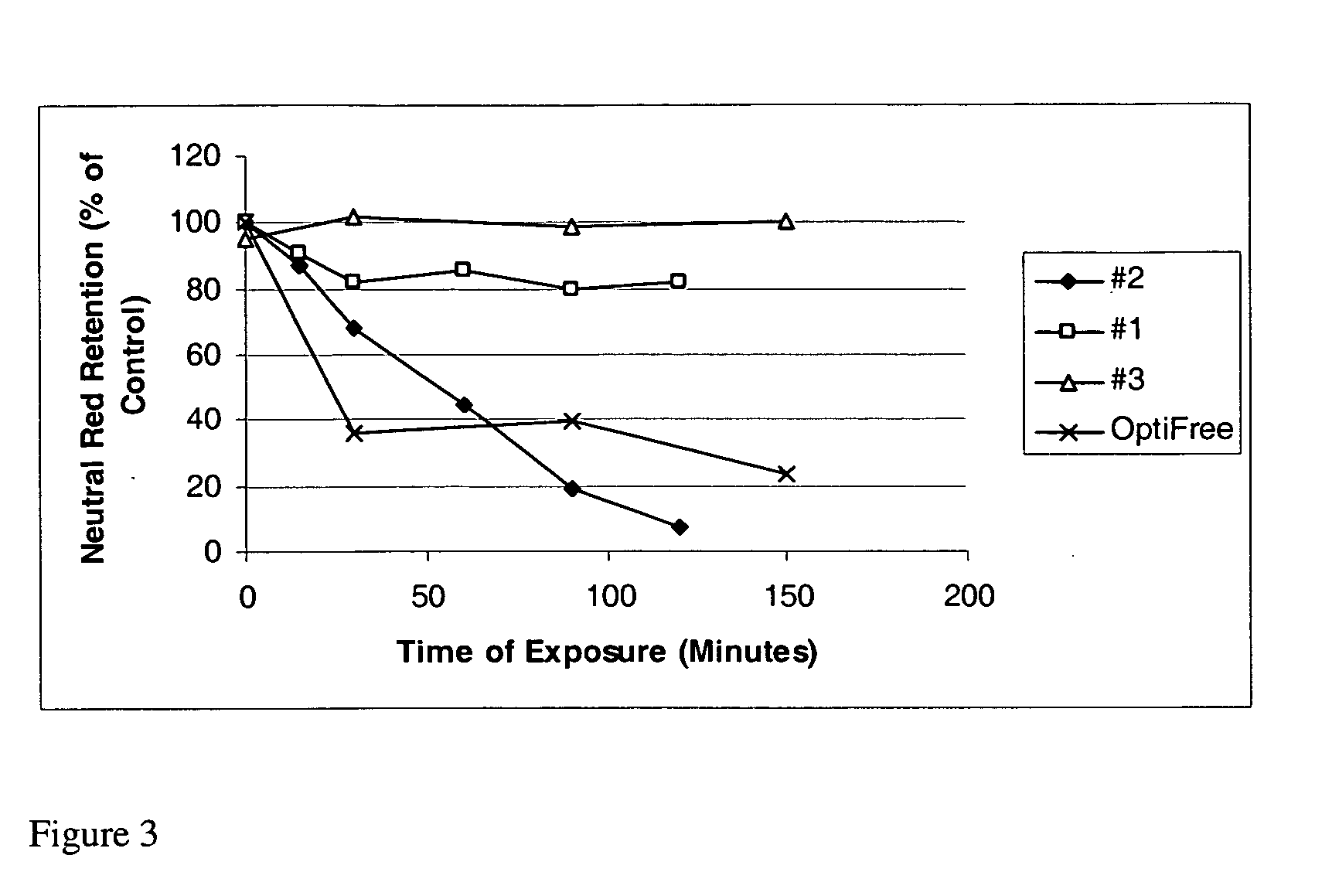Borate-polyol mixtures as a buffering system
- Summary
- Abstract
- Description
- Claims
- Application Information
AI Technical Summary
Benefits of technology
Problems solved by technology
Method used
Image
Examples
example 1
[0062] As discussed above, the borate-polyol buffering system according to the present invention may be designed to have a pKa that is significantly lower than those known in the art to date. FIGS. 1A and B display pH buffering profiles for mixtures of sorbitol and boric acid. The detailed formulations are listed in Table 1.
[0063] It can be seen that the pH buffering zone for Formulation #1, which has a lower borate-polyol concentration, is from 4.1 to 9.0, and the pH buffering zone for Formulation #2, which has a higher borate-polyol concentration, is from 6.5 to 9.7. The pKa values of the two formulas are 6.6 and 8.1, respectively (see Table 1).
[0064] The buffering system displayed in these solutions may be readily contrasted with the traditional boric acid buffer, which has been widely used in ophthalmic preparations. The weakness of the boric acid buffer is that its pKa (9.0) is far from the physiological pH range. To overcome this high pKa value, ophthalmic preparations usual...
example 2
[0066] The borate-polyol complex buffer according to the present invention has a wide buffering zone range and a pka value that may be adjusted to meet any pH buffering need for physiological compositions.
[0067] Table 2 shows the osmolality change when boric acid and sorbitol form complexes. The osmolality was measured using techniques well-known in the art. By way of example, osmolality may be measured using an osmometer such as the Advanced® 2020 Multi-Sample Osmometer (Advanced Instruments, Inc., Norwood, Mass., USA).
[0068] The third column of Table 2 shows the osmolality reduction in the solution which indicates the complex formation between boric acid / borate and sorbitol. Assuming 1:1 or 1:2 complexation ratio of boric acid to sorbitil (see fourth and fifth column of Table 2, respectively), the percent of the boric acid which complexes with the polyol is a small portion of the total boric acid available. The larger the molar ratio of sorbitol to boric acid, the higher the com...
example 3
[0069] The disadvantage of a traditional boric acid buffer for a contact lens cleaning, disinfecting, rewetting, and / or storage solution is that it can swell some types of contact lenses. An example of such a contact lens is the Aquavision lens (formerly the Actisoft lens (Bahrain Optics Co W.L.L.)). With the Aquavision lens, it is believed that the borate (either alone or mixed with boric acid) buffer swells contact lenses containing polyol groups in the lens materials.
[0070] In contrast to traditional boric acid buffers, borate-polyol complex buffers according to the present invention do not swell any contact lenses that are currently on the market.
[0071] Table 3 illustrates effect of five solutions on the Actisoft lens: the first 3 contain a traditional boric acid buffer, while the last 2 contain a buffer according to the present invention. As shown by Solution 3, a boric acid buffer may swell a lens as much as 0.57 mm. Sodium borate also swells Aquavision® lenses as much as 0....
PUM
 Login to View More
Login to View More Abstract
Description
Claims
Application Information
 Login to View More
Login to View More - R&D
- Intellectual Property
- Life Sciences
- Materials
- Tech Scout
- Unparalleled Data Quality
- Higher Quality Content
- 60% Fewer Hallucinations
Browse by: Latest US Patents, China's latest patents, Technical Efficacy Thesaurus, Application Domain, Technology Topic, Popular Technical Reports.
© 2025 PatSnap. All rights reserved.Legal|Privacy policy|Modern Slavery Act Transparency Statement|Sitemap|About US| Contact US: help@patsnap.com


